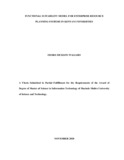FUNCTIONAL SUITABILITY MODELFORENTERPRISERESOURCE PLANNING SYSTEMS IN KENYAN UNIVERSITIES
Abstract
Managementof institutions needs correctinformation to enhance their competitiveness.Universities, just like any other institutionrequires proper information for decision-making. In universities,there are complex processes, and related activities that require proper decisions. Automation brings in a myriad of benefitsto the users of the systems or software being implemented. Universities today have embraced Enterprise Resource Planning Systems in their processes. However, the challenge is onhow useful their functionalities areto the institutionsbecause of theunique nature of their processes. Given Enterprise Resource Planning Systemsmostly are standard applications;there is need for a well thought out approach to determine the functionality of these systems in order to reap from their benefits. The main objective of the study was to develop a model to measure functionalityof enterprise resource planning systems in KenyanUniversities.To achieve this, the study was guided by the following specific objectives:Determine the status of Enterprise Resource Planning Systemimplementation in Kenyan universities, and identify the factors that affect the functionalities of the Enterprise Resource Planningsystems in universities. The study adopted exploratorydesign, the study focused on the features incorporated in the Enterprise Resource Planning Systemand mapped out these features with the users’ expectations of the system. Sample population was selected using both purposive sampling and simple random sampling techniques. The population of interest in this study werethe users of Enterprise Resource Planningsystem; staff members, technical Information Communication Technologystaff and the top management staff. The main data collection instruments were content analysis, interviews and questionnaires. The study employed mixed approach where both quantitative and qualitative data was used. Quantitative data was analyzed using inferential statistics and presented usingtables.Onthe other hand, thematic analysiswasused for qualitative data and presented using themes. The study presents a Model to measure functionality of Enterprise Resource Planning Systemfor universities. Apart from developing a better user interaction and operation, the findings presented can be used by educational policy makers, Enterprise Resource Planningsystem developers, systems administrators and other stakeholders in the academic environment in implementation and smooth running of these systems in the academic environment.

